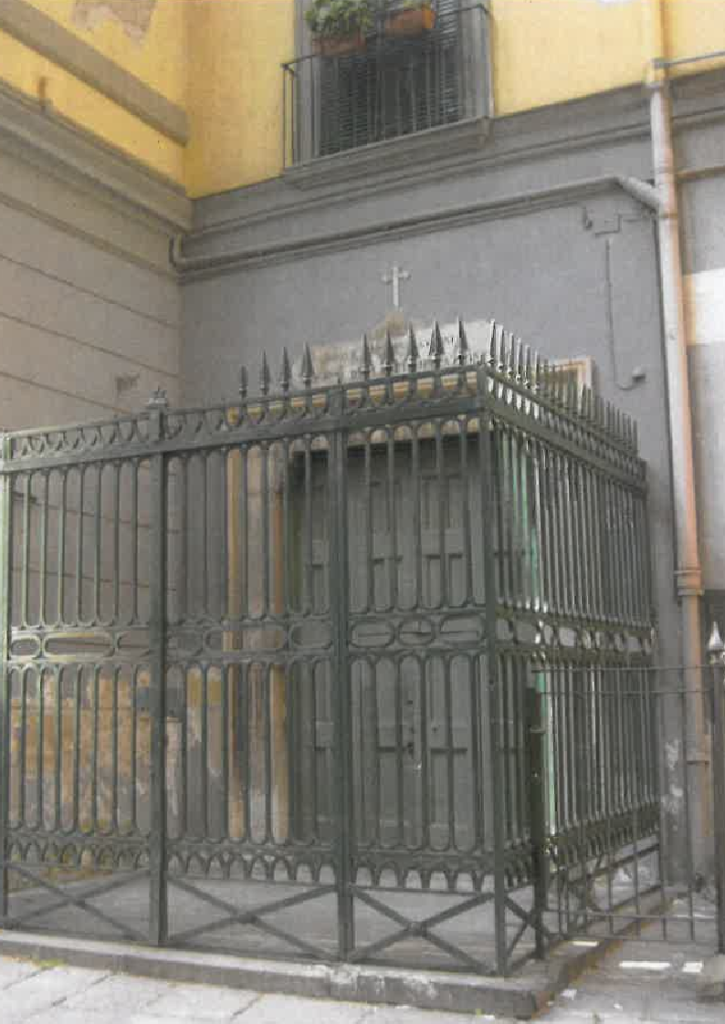The old synagogue in Naples

The presence of a significant Jewish community in Naples can be traced back to Roman Times, and there is evidence that the community spread throughout three distinct municipal areas covering a large part of what is today’s historical city center.
There is a 10th century document mentioning a great synagogue with a ceremonial bath (mikveh) located near the city walls not far from the sea. The building in question must date back to at least the 5th century, after which time Byzantine law prohibited the building of further Jewish religious edifices. The synagogue in question, like all the others, was ultimately confiscated and converted into a church in 1290, and initially the building was used as a reformatory for Jewish women converted to Christianity, and it remained a center for catechesis until 1500 when this women’s institution, now known as the “Daughters of Saint Catherine” was moved by order of the Spanish Viceroy in Naples, Pedro da Toledo, to the church of Sant’ Eligio.
Through research by Dr. Ciro Moses D’Avino, President of the Judaica Mediterranea Association, and Rav Sholmo Backbuth, former Chief Rabbi for Naples and Southern Italy, it has come to light, thanks to its peculiar architectural renatures, that the Catholic Church known as Santa Caterina Spain Corona can now be identified as the Great Synagogue of pre-Byzantine Naples. In fact, the main clue lies in the traces of the mikveh still visible in a small rectangular space to the right of the church’s single nave. There are three steps leading down into what was once the pool used as a mikveh, and we can still see two pipes through which rainwater channeled into the pool. There are also traces of two raised lateral areas which formerly served to separate the sexes during services. Women were segregated to the side rooms to which they had access by means of a second entrance now walled up but still visible, and a narrow stairway which led to the room from which they could watch the services unseen and, in another direction the mikveh reserved from women, far from prying eyes. In addition, there remain some traces of an ancient Hebrew text preserved in photographs taken by Dr. D’Avino, who caught them just in time to preserve a record for posterity before it faded away completely.
The synagogue is rectangular in shape and can be reached by taking a long flight of steps below street level. This is typical of ancient synagogues: one thinks of the Prague synagogue dating back to the 1200s, hitherto considered to be the oldest in Europe. The reason for such subterranean structures can be found in Scripture, in particular in Psalm 129: “Out of the depths I cry to thee, ho Lord; Lord Hear my voice…” among others.
Amazingly, this discovery places the Naples synagogue as the oldest in Europe if we consider that up to know the most ancient ones (Prague in the Czech Republic, and Trani in Italy) both date back to the 1200s. The presence of this Synagogue is yet another example of Naples’ rich artistic and architectural heritage, despite the trials caused by volcanic activity and earth quake in the area.
The center of Naples boasts a number of other synagogues of smaller dimensions reflecting the fortunes of the Jewish Community in the city through the ages. A few of these synagogues situated within the historical city center also had their own mikvehs and rabbinical schools, some of them rising on land sold to them by the Church.
Throughout the 13th Century, Jews continued to settle in the area, and we have records of a certain Mele Sacerdote who moved to Naples in 1246 with his wife Regina and two sons. They paid for the construction of a Mikveh for their local synagogue, but in the sixteenth century, the premises were absorbed into the fabric of the church of San Marcellino, which still stands. The synagogue itself is a simple quadrilateral structure with a Roman marble portal, which suggests the recycling of material or the adaptation of an older structure, traces of many of which abound in the area, all dating from the first century BCE to the early second century CE. Next to it is a modern coffee bar, rectangular in shape and structurally speaking of the same date, and we can assume it was used in the early days as a Yeshiva. The evidence for this supposition comes from the presence of a subterranean room which until a few years ago was intact under the bar. Inside the room is a staircase leading directly into a stone bath with a ledge for seating running along three sides. It would seem reasonable to presume that this is the mikveh built by the Sacerdote family.
In 2012, the local Cardinal, Constanzio Sepe announced that the Catholic Church was willing to return the Synagogue to the Jewish Community if and when they applied repossession, though current lack of funding for the extensive restoration required has meant that this generous offer has yet to be taken up, as today’s active Jewish community in Naples is very small and unfortunately has limited resources. Consequently, this jewel in the crown of Neapolitan Jewry risks remaining hidden forever, or at any rate out of Jewish hands.
